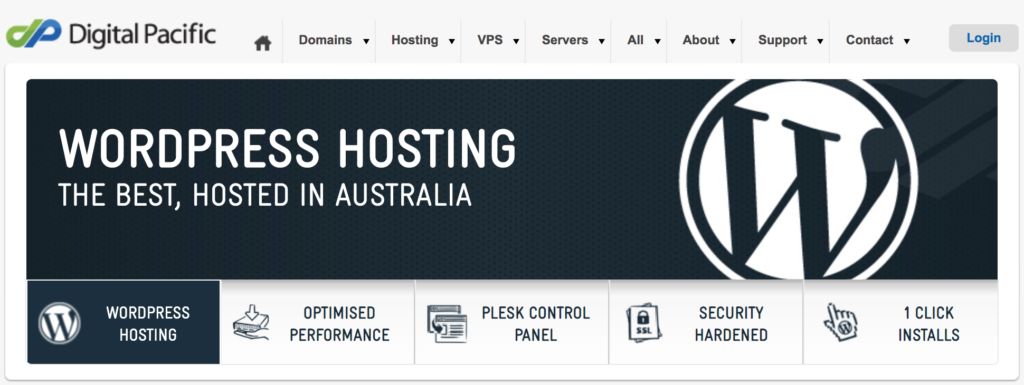Digital Pacific is one of a small number of web hosting providers with physical presence in Australia. Since your website loading speed is so important, especially on mobile devices it’s important for Australian businesses to take any speed advantage they can get. Hosting your website locally is the best way to reduce the delay in requesting and receiving the data from the server. Every millisecond counts, and the sooner your website appears on the screen, the more likely your customers are to take the action you want.
So, I am testing Digital Pacific’s “WordPress Hosting – Standard“. For my tests, I will be testing a WordPress website running with our standard combination of plugins and the GeneratePress theme to see how it performs under Australian conditions. This is the same configuration used for my other WordPress hosting performance tests.
Digital Pacific’s primary hosting location is in Sydney, so I would expect to see some excellent speeds.
Our standard configuration:
In my test setup, WP Smush Pro will be used to ensure all images are optimised, however the WPMU Dev CDN connection will be disabled to ensure that I get an accurate reflection of the Digital Pacific hosting.
Digital Pacific uses Plesk’s WordPress add-on for their WordPress hosting, and while there are no controls within your Plesk dashboard, there is an optional add-on called “Plesk SpeedKit”. For these tests, SpeedKit is disabled.
Initially, I’ll test with all caching disabled, then again with different combinations of Hummingbird Pro’s caching and optimisation settings active. I expect this should give us better results.
For these tests, I’ll be using an average size WordPress website for a service-based business. It sports an assortment of images and different kinds of Elementor objects and templates, including an embedded YouTube video, so it should give a reasonable reflection of the performance of a website built on GeneratePress using Elementor Pro.
Also of note is that at the time of testing, our Digital Pacific server was running PHP version 7.3 and had a free Let’s Encrypt SSL certificate.
Speed test platforms
I will be using three test platforms
The first test platform will be Google PageSpeed Insights since this provides feedback directly from Google on how it sees your website.
The second will by Pingdom Tools using the Sydney test location to ensure we are seeing results reflective of the Australian experience.
The third test platform will be GTMetrix, also set to the Sydney test location.
Digital Pacific WordPress Hosting - Standard
For this test I have no optimisation enabled through Hummingbird Pro and caching is entirely disabled.
Google PageSpeed Insights
Mobile rating
29 100
- First contentful paint: 3.5 seconds
- Speed index: 14 seconds
- Time to interactive: 9.0 seconds
Desktop rating
64 100
- First contentful paint: 1.0 seconds
- Speed index: 4.7 seconds
- Time to interactive: 2.5 seconds
Pingdom Tools
- Load time: 2.08 seconds
- Requests: 63
- Page size: 4.2 MB
- Wait time for server response: 991.5 ms
Performance grade
80 100
GTMetrix
PageSpeed score
85 100
- Load time: 3.8 seconds.
- Page size: 3.99 MB
Yslow score
77 100
- Requests: 64
- Time-to-first-byte: 0.7 seconds
GTMetrix flags 1mb of JavaScript from the embedded YouTube video as delaying the initial page load.
Digital Pacific WordPress Hosting - Standard with Hummingbird Pro enabled
For this test, I enabled Hummingbird Pro’s persistent cache. Hummingbird Pro also had GZIP compression enabled, but all asset optimisation was turned off.
Google PageSpeed Insights
Mobile rating
33 100
- First contentful paint: 3.2 seconds
- Speed index: 10.2 seconds
- Time to interactive: 8.9 seconds
Desktop rating
68 100
- First contentful paint: 0.9 seconds
- Speed index: 3.3 seconds
- Time to interactive: 2.5 seconds
Pingdom Tools
- Load time: 1.15 seconds
- Requests: 63
- Page size: 4.2 MB
- Wait time for server response: 107.9 ms
Performance grade
80 100
GTMetrix
PageSpeed score
85 100
- Load time: 2.5 seconds.
- Page size: 4.0 MB
Yslow score
77 100
- Requests: 61
- Time-to-first-byte: 0.04 seconds
GTMetrix flags 1mb of JavaScript from the embedded YouTube video as delaying the initial page load. There are no other negative flags.
Digital Pacific WordPress Hosting - Standard with Hummingbird Pro enabled and Assets Optimised
For this test, I ran the Hummingbird Pro persistent cache with all CSS files combined and all CSS and Javascript files moved to the footer. Now, Hummingbird Pro does note that Digital Pacific is running the HTTP/2 protocol which automatically optimises assets, so this optimisation may not make a huge difference.
Google PageSpeed Insights
Mobile rating
31 100
- First contentful paint: 3.5 seconds
- Speed index: 9.3 seconds
- Time to interactive: 9.1 seconds
Desktop rating
67 100
- First contentful paint: 0.9 seconds
- Speed index: 3.4 seconds
- Time to interactive: 2.5 seconds
Pingdom Tools
- Load time: 1.1 seconds
- Requests: 63
- Page size: 4.2 MB
- Wait time for server response: 123.2 ms
Performance grade
80 100
GTMetrix
PageSpeed score
85 100
- Load time: 4.0 seconds.
- Page size: 3.99 MB
Yslow score
77 100
- Requests: 64
- Time-to-first-byte: 0.035 seconds
GTMetrix flags 1mb of JavaScript from the embedded YouTube video as delaying the initial page load.
How does it look in a chart?
Load Speed
Google PageSpeed Insights
Observations and final thoughts
Unexpectedly, while Pingdom Tools did report the best loading speeds with asset optimisation turned on, Google PageSpeed Insights and GTMetrix both reported that the best performance was attained using Hummingbird Pro with asset optimisation turned off.
That said, the overall loading times were good. However, they could definitely be better. The key to these speeds is the time to first byte, also known at the wait time from when the browser sends the request until it receives something back from the server.
Now, on it’s own, fast response time does not a fast server make.
It certainly helps though!
Looking at the overall performance ratings, it looks to me like there is room to improve. Perhaps using the optional Plesk Speed Kit which claims speed improvements of between 50% and 300%. Perhaps the test site could use some further work on optimisation itself.
Digital Pacific’s WordPress Hosting – Standard is a great option for Australian WordPress websites, especially lower traffic ones. The response times are some of the best you can get in Australia, so if you can make the most of that and really dial in your WordPress site, then you should be able to get even better speeds then I got here. Price wise, it is a bit on the high-side unless you pre-pay for multiple years. That said, after you take into account currency conversions for other big players in the WordPress hosting space, they are not dissimilar from the likes of Flywheel and they do come in much cheaper than WP Engine. Using a caching plugin like Hummingbird Pro does improve performance, but asset optimisation is questionable, in part because of the built in HTTP/2 support on Digital Pacific.
Overall, this is a great option for speed in Australia that isn’t excessively priced. I do think pricing could be more competitive, but if you are willing to jump in for 2 or 3 years it does make the pricing very good.
Tip:
The closer the server or CDN is to your end users, the faster that those users will receive the first byte of data.







